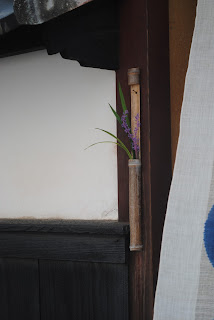Saturday was the deadline for the exhibition, and as most architects every last minute was used. Model people placed in models and text for everything. The final touchup with flowers, trees and everything made it all come together in a bigger symbiosis. I got permission to post pictures of their exhibition now, since I don't have a lot of Japanese following my blog. So maybe now is the the time to write what this exhibition is all about.
From the beginning
I worked with Kato at COBE Architects in Copenhagen. When I was in Japan last year on a study trip I met Victoria. Kato asked me to come help build models ( That is also what I have been doing at COBE the last couple of years). I think it was probably mostly a joke at first, I was open for the idea. Don't think they thought anyone would travel so far on so short notice. But I thought it would be a great opportunity to see how they work and meet other Japanese architects. So finally after a bit of thought of a unrealistic trip to Japan my Grandfather Gordon Moodie said he would like to sponsor the trip with a plane ticket. Thank you so much, for making it possible.
So the Exhibition...
It is called Under 30 Architects. I might have mentioned that before. So they picked 7 architects under 30. They exhibit ideas for projects or projects that have been built or are going to be built. Which is what Kato and Victoria are exhibiting. In five years or so Lucky House will be built in Denmark. It is an allotment, using parts of the existing house to create a new house. Lucky house divides the functions of the house into individual rooms spread out on the plot connected by facades folding out and creating shelter, terraces, and small gardens. The rooms all have a strong connection to the garden, which has been one of the main ideas through the process. Instead of separating the garden from the house as we usually do, they have tried to combine and connect living and nature. I have mainly been working on making the sketch models for the exhibitions, making furniture and placing trees, assembling and so on. My favorite is the Knitted House. I really like how the house creates a small central garden while making small spaces in the outside garden. Another thing I really like about their project is the idea of breaking down the boundaries between inside and outside. This is also something I worked with in my bachelor project.
Developing the concept of the allotment
After making the Lucky House Kato and Victoria started working on the idea of how to reinvent the allotment. This is what the big foam installation is. The idea of the stacked allotments are displayed in three different scales. The 1:5 is the biggest which creates the exhibition space where they display everything. In the 1: 5 model, one 1:10 and 1:100 model is displayed. Probably it makes more sense when you see the photos. The Lucky house is exhibited in two different scales, the big one in 1:50 and a small one in 1:100. There is a short introduction to what a allotment is. I guess it is a very danish phenomenon. It is a small house in a garden often close to the cities or in the city, uses by people living in apartments with out gardens or just as a retreat. Picked fences, garden trolls, hoisted danish flags the smell of grilled sausages and bare bellies toasting in the sun with a cold beer by its side. Many grow vegetables, and some even move to the little house during the summer period.
Last but not least there are the five sketch models exhibited in 1: 100, to show the process of how they came up with the idea of Lucky House.
It has been really interesting helping with the exhibition, watching everything come together. I met a lot of nice people who came to help. Some Japanese architecture students, some Japanese architects, artist and friends. I even met a Japanese girl who is going to my school for exchange next semester. That was quite a coincidence. A big thank you to my friend Maj who came all the way to Japan to see what I work with and help out. It has been so nice to have her here, to share the experiences with, it would not have been the same without her! Looking forward to showing her some of my favorite spots in Japan. Next stop Naoshima.
Victoria & Kato
Model of the whole exhibition.
Zoom of Kato & Victorias exhibition space.
Existing house and Lucky House 1:100
Allotments
Knitted House - Sketch model
Sketch model
Sketch model
Sketch model
Sketch model
Lucky House 1:50
Allotment development 1:10





















































